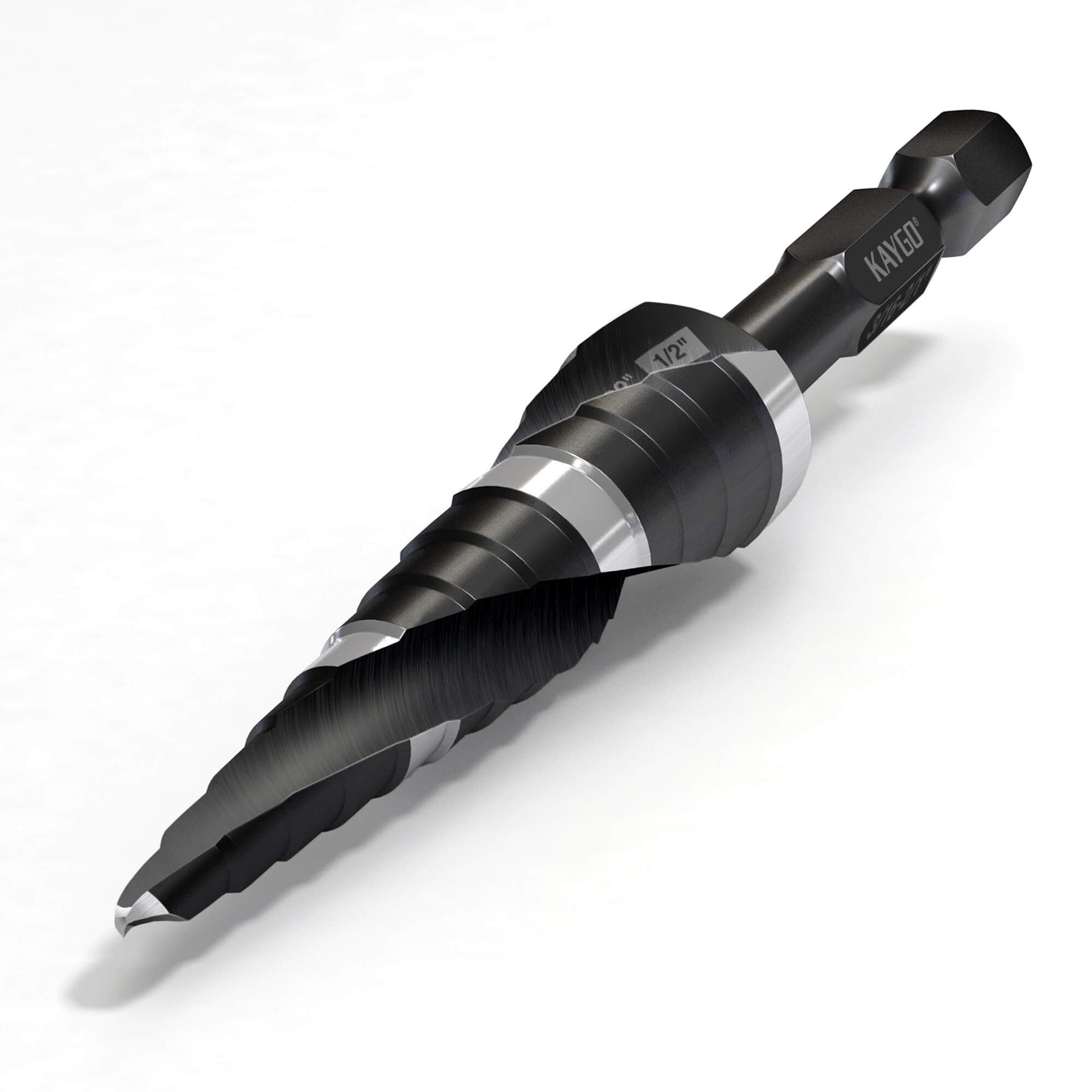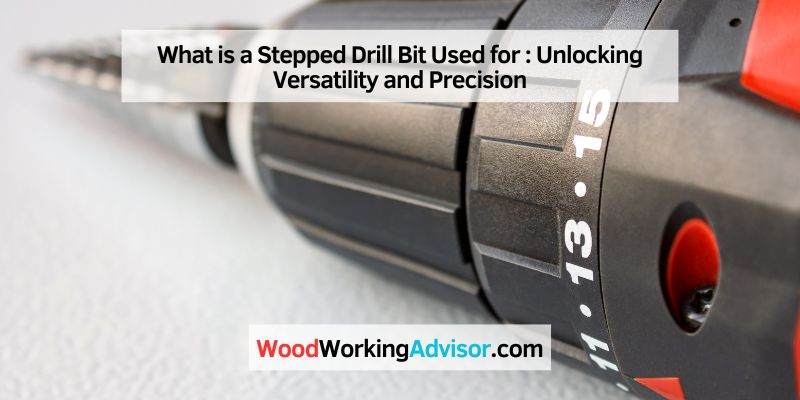A stepped drill bit is used for creating precise and varying-diameter holes in different materials. When working on a project that requires drilling holes of different sizes, a stepped drill bit can be a handy tool.
It is designed with a gradually increasing diameter and distinct steps, allowing users to drill holes of varying sizes without the need for multiple drill bits. This type of drill bit is commonly used in metalworking, plumbing, and carpentry tasks.
With its ability to create precise and clean holes, the stepped drill bit offers convenience and efficiency. Whether you need to enlarge an existing hole or create a series of stepped holes, this versatile tool is a reliable choice.
Exploring Stepped Drill Bits
A stepped drill bit is a versatile tool that has gained popularity in various industries and among DIY enthusiasts. These specialized drill bits provide an efficient way to drill holes of different diameters without the need for multiple bits. In this article, we will delve into the world of stepped drill bits, exploring what they are, their types, and how they can be used effectively.
What Are Stepped Drill Bits?
Stepped drill bits, also known as step bits or ladder drill bits, are designed with multiple cutting edges of varying sizes. Unlike traditional drill bits with a single cutting edge, these unique tools feature a stepped profile, allowing them to create holes with different diameters in a single operation. Each step on the bit corresponds to a specific hole size, providing a convenient way to drill holes of various sizes without the need for bit changes.
Types Of Stepped Drill Bits
There are different types of stepped drill bits to suit various drilling needs:
| Type | Description |
|---|---|
| Single Flute | These bits have a single large flute that helps in faster chip removal and prevents clogging. They are suitable for use with thinner materials. |
| Double Flute | Double flute stepped drill bits have two flutes that help in smoother drilling and better chip evacuation. They are ideal for use in thicker materials. |
| Titanium Coated | Titanium-coated stepped drill bits offer increased durability, heat resistance, and reduced friction. The coating helps to extend the life of the bit and enhances drilling performance. |
| Variable Flute | Variable flute stepped drill bits have multiple flute sizes that allow for versatile drilling in different materials. These bits provide excellent control and reduce the risk of bit breakage. |
It’s important to choose the right type of stepped drill bit based on the material you are working with and the specific hole sizes required.

Credit: kaygosafety.com
Applications In Various Industries
A stepped drill bit is a versatile tool that finds applications in various industries such as metalworking, woodworking, and carpentry. Its unique design allows for efficient drilling through different materials by gradually enlarging holes in a single operation. Let’s explore how this tool serves specific purposes in each of these industries:
Metalworking
In the metalworking industry, the stepped drill bit is highly valued for its ability to create clean and precise holes in various types of metal. From aluminum to stainless steel, this tool can effortlessly drill through different thicknesses, resulting in smooth and accurate holes. Its stepped design eliminates the need for multiple drill bits or step drilling, saving both time and effort for metalworkers. Common applications include fabricating metal frames, assembling machinery, and working on automotive projects.
Woodworking And Carpentry
When it comes to woodworking and carpentry, the stepped drill bit is an indispensable tool for creating dowel joints. These joints provide strong and seamless connections between wooden pieces, ensuring the stability and durability of furniture, cabinets, and other wooden structures. By using a stepped drill bit, carpenters and woodworkers can easily achieve precise hole diameters for inserting dowels. This promotes accurate alignment and snug fits, resulting in professional-looking finished products. Additionally, this tool is also useful for countersinking screws in wooden materials, allowing for flush installations.
Advantages Over Traditional Bits
Increased Versatility
Stepped drill bits offer increased versatility compared to traditional bits. With their multiple cutting edges and various stepped diameters, they allow for drilling holes of different sizes without the need for changing bits. This means that a single-stepped drill bit can replace a set of traditional bits, making it a more convenient and cost-effective option for various drilling tasks.
Enhanced Precision
One of the key advantages of stepped drill bits over traditional bits is the enhanced precision they provide. The multiple steps on the bit enable users to achieve precise hole sizes, which is essential for projects that require accuracy. This can be particularly beneficial in applications such as electrical work and metal fabrication, where exact hole dimensions are critical for fittings and components.
Choosing The Right Stepped Drill Bit
When it comes to drilling various sizes of holes in different materials, a stepped drill bit is an indispensable tool. Its versatile design allows you to drill holes of different sizes without the need for multiple bits. However, selecting the right stepped drill bit for your specific application is crucial to achieving optimal results. Here are some considerations to keep in mind when choosing the right stepped drill bit:
Considerations For Material
Different materials require different types of stepped drill bits to ensure efficient drilling. The hardness and thickness of the material play a significant role in determining the suitable type of bit. Here are a few material considerations to help you make the right choice:
- For softer materials like wood and plastic, HSS (High-Speed Steel) stepped drill bits are ideal. They offer excellent performance and durability for these materials.
- When working with harder materials such as metal or stainless steel, cobalt steel stepped drill bits are recommended. These bits are designed to withstand the high heat generated during drilling and are more resistant to wear.
Selecting The Correct Size
Choosing the correct size of the stepped drill bit is essential for achieving precise and accurate holes. To ensure you select the right one, consider the following factors:
- Identify the specific hole sizes you need to drill. Stepped drill bits typically have multiple steps, each capable of drilling a range of hole sizes.
- Refer to the product specifications or the size markings on the stepped drill bit to identify the range of hole sizes it can accommodate.
- Consider the thickness of the material you are drilling. Some stepped drill bits may have limitations when it comes to drilling through thick materials, so be sure to choose a bit capable of handling the desired depth.
By considering the material and selecting the correct size, you can ensure that you choose the right stepped drill bit for your drilling needs. This will result in precise and efficient drilling, saving you time and effort.
Tips For Optimal Usage
Proper usage of a stepped drill bit is essential to achieve accurate drilling and maintain the longevity of the tool. By following these tips, you can ensure optimal usage and get the most out of your stepped drill bit.
Proper Drilling Techniques
Here are some important tips for using a stepped drill bit with proper drilling techniques:
- Start with the right material: Know the specific material you will be drilling into and ensure that the stepped drill bit is suitable for that material.
- Secure the workpiece: Use clamps or a vise to firmly secure the workpiece before starting the drilling process. This will prevent any unwanted movement or slips.
- Mark the drilling point: Use a marker or punch to clearly mark the spot where you need to drill. This will serve as a guide for accurate drilling.
- Start with a pilot hole: For thicker materials or when drilling larger-diameter holes, it is advisable to start with a small pilot hole. This helps in creating a center point for the stepped drill bit and prevents it from wandering.
- Apply steady pressure: While drilling, apply consistent and steady pressure on the drill. Avoid exerting excessive force, as it may lead to overheating or breakage of the stepped drill bit.
- Control drilling speed: Use a variable speed drill or adjust the speed of the drill to match the requirements of the material being drilled. Higher speeds are generally suitable for softer materials, while slower speeds are recommended for harder materials.
- Clear chips regularly: Clear the chips and debris from the hole regularly to maintain the cutting efficiency and prevent the bit from getting stuck.
Maintenance And Care
To ensure the longevity and effectiveness of your stepped drill bit, it is important to follow proper maintenance and care practices:
- Clean after use: After each use, clean the stepped drill bit thoroughly. Use a soft brush or cloth to remove any debris, dust, or residual material from the cutting edges.
- Inspect for damage: Regularly inspect the stepped drill bit for any signs of wear, damage, or dullness. If you notice any deficiencies, replace the bit to maintain optimal performance.
- Store properly: Store the stepped drill bit in a dry and secure place to prevent exposure to moisture or potential damage. Consider using a designated container or case to protect it.
- Sharpen when needed: If the cutting edges become dull, sharpen the stepped drill bit using an appropriate sharpening tool. This will help restore its cutting efficiency.
- Follow manufacturer’s recommendations: Always refer to the manufacturer’s guidelines and instructions for specific maintenance and care requirements of your stepped drill bit.
By following these proper drilling techniques and maintenance practices, you can optimize the usage of your stepped drill bit and achieve precise and efficient drilling results.

Credit: www.amazon.com
Frequently Asked Questions For What Is A Stepped Drill Bit Used For
What Is A Stepped Drill Bit For?
A stepped drill bit is used to create multiple hole sizes with one bit. It is efficient and versatile for drilling different-diameter holes.
What Are The Disadvantages Of Step Drill Bits?
Step drill bits have some disadvantages. They may become dull quickly, especially when used on hard materials. They are not suitable for drilling large holes or heavy-duty applications. The stepped design can result in uneven hole sizes. Additionally, they can be more expensive compared to traditional drill bits.
Are Step Drill Bits Worth It?
Step drill bits are definitely worth it. They offer versatility by allowing you to drill multiple hole sizes with just one bit. This saves time and money since you won’t need to buy multiple bits. Plus, they provide clean and precise holes in materials like wood, plastic, and metal.
How Do You Use A Step Drill Bit Set?
To use a step drill bit set, secure the material, select the appropriate size, and mark the hole location. Insert the bit into the drill chuck, apply light pressure, and let the bit do the work. Use cutting oil for metal to prevent overheating and wear safety goggles.
Conclusion
A stepped drill bit is a versatile tool for various drilling tasks. It provides efficiency and convenience by allowing multiple hole sizes with a single bit. Whether for DIY projects or professional use, this tool is a valuable addition to any toolbox.
Its ability to create clean and precise holes makes it indispensable for woodworkers, metalworkers, and DIY enthusiasts alike.


